Punjab State Board PSEB 10th Class Physical Education Book Solutions Yogic Exercises or Asanas Game Rules.
Yogic Exercises or Asanas Game Rules – PSEB 10th Class Physical Education
Question 1.
Write about the history of Yoga.
Answer:
History:
The history of Yoga is indeed very old. Nothing can be said firmly about the origin of Yoga. Only it can be said that Yoga was originated in India. The available evidences show that history of Yoga is related to Indus Valley Civilization. At that time people used to do Yoga. On the basis of secondary sources it can be concluded that Yoga was originated approximately in 3000 B.C. in India. The first book on Yoga was written by Patanjali in 147 B.C. Infact, Yoga is derived from a Sanskriti word “Yuj” which means union of soul.
Nowadays, Yoga has become very popular throughout the world. The present age can be said the age of stress, tension, and anxiety. So, most of the persons have not been leading a happy and fruitful! life. In western countries, Yoga has become a way of life. It has a vital significance in the life of human beings.
![]()
Question 2.
Which important points should be kept in mind while doing yogasanas.
Answer:
Latest information about Yoga:
- The ground should be even for doing Yogic exercises. Yogic asanas should be performed on a ‘dari’ or blanket on the ground.
- The place for Yogic asanas should be peaceful, airy and clean.
- Breathing should be normal, and mind should be at peace while doing Yog Asanas.
- Yog Asanas should be performed with concentration of mind at least four hours after taking meals.
- The exercises should be done slowly and with ease, and the pace of the exercises should be increased slowly.
- The Yogic practice should be done under the care of an expert.
- One should get relaxed by Shavasana in between two Yogic Asanas.
- The body should be covered with minimum clothes such as loin cloth, nickar, banyan etc. and balanced food should be taken.
The following exercises have been included in the syllabus prescribed by the Board. Daily practice of these exercises helps a layman keep good health:
- Tarasana
- Ardh Chandrasana
- Bhujangasana
- Shalabhasana
- Dhanurasana
- Ardhmatseyendrasana
- Paschimotanasana
- Padmasana
- Sawastikasana
- Sarvanagasana
- Matasyasana
- Halasana
- Yog Mudra
- Mayurasana
- Uddiyana
- Pamayamanulom vilom
- Surya Namaskar
- Sharasana.
Some of the important asanas out of the above-mentioned asanas are described ahead in detail, and others have been described in brief:
1. Tar Asana:
In this asana the trunk is pulled upwards while in the standing position. The position of tar asana is like the Tar tree.
Technique of the Tar Asana-
Stand up, join the heels and toes of both the feet and lift the arms straight upward. Let the fingers of one hand cross those of the other hand. The wrists should be upward and the sight in front. Breathe in fully. Raise the heels and put the whole body weight on toes. Pull the body upwards. After sometime, breathe out and lower the body. Repeat this action 10-15 times.
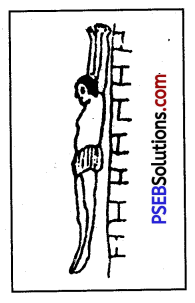
Advantages of Tar Asana:
- It reduces obesity of the body.
- It raises the stature.
- It removes constipation.
- It prevents the diseases of the intestines.
- It serves to cleanse the bowels if it is done after taking cold water everyday.
2. Ardh-chandra Asana:
It involves the same action as is in Tar Asana. In it, the body is bent to side said, and the other side of the trunk is pulled.
3. Bhujangasana: In this asana, one lies down straight and loosens the trunk.
![]()
Question 3.
What are the benefits of Bhujang asana.
Answer:
Technique of Bhujang asana:
It is also called Sarapasana. In it, the position of the body is like that a serpent. In order to perform this asana, lie down on the belly on the ground. Place both hands near the shoulders. Make the legs hard slowly and with the help of wrists raise the chest so much that the body gets completely straightened. Pull in the toes and hang the head slowly backwards. Return gradually to the former position. Repeat this asana 3-5 times.
Advantages:
- Bhujangasana stimulates (increases) the digestive power.
- It helps in getting rid of the diseases of liver and spleen.
- It strengthens the muscles and the vertebral column.
- It removes constipation.
- It helps in making the bulging- out belly go in.
- It strengthens lungs.

1. Shalabh Asana: In this asana, one lies prostrate and the thigh spreads backward.
2. Ardh Masteyendr Asana: In this asana, in sitting position, the trunk is pushed towards the sides.
3. Dhanur Asana: In this asana, one lies prostrate, pulls up the legs and tries to catch dr catches the knee with the help of both hands.
![]()
Question 4.
What is the difference between Dhanur Asana and Paschimottan Asana?
Answer:
Technique of Dhanur Asana:
In this asana the position of the body is like that of a bow. In order to perform this Asana, lie over the belly on the ground, keep the knees bent backwards. Hold the feet near the ankles with the help of both the hands. Breathe in deeply and raise the chest upwards as much as possible. Now make the feet hard so that the body acquires the shape of a bow. Try to remain in this position as long as possible. Breathe out, keep the body loose and return to the former position. Repeat this asana 3-4 times.
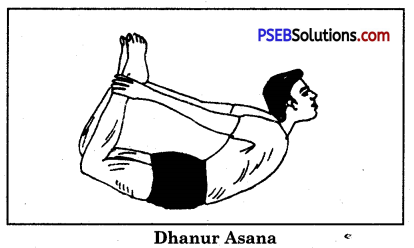
Dhanur Asana:
Advantages:
- It reduces the obesity (fatness) of the body.
- It increases the power of digestion.
- It helps in getting rid of rheumatism and urinary diseases.
- It strengthens the stomach and intestine.
- It also strengthens the vertebral column. Muscles become strong and flexible.
1. Paschimottan Asana: In this asana, one holds the thumbs of the feet with fingers and sits in such a way that the trunk goes towards one side.
Position of Paschimottan Asana: In this asana, the whole body is stretched and bent.
Technique of Paschimottan Asana:
Spread both the legs forward and sit on the ground. Hold the thumbs of the feet with both the hands. Breathe out slowly. Try to touch the knees. Breathe in slowly, raise the head upwards and returns to the former position. This asana should be performed 10-15 times.
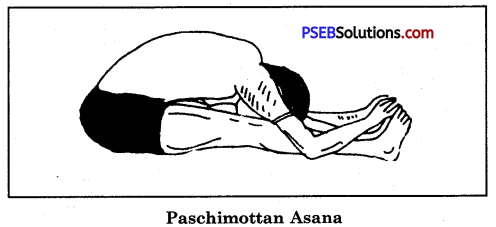
Advantages:
- This asana provides strength to the thighs.
- It cleanses the blood vessels.
- It helps in getting rid of the various types of diseases of the belly.
- It lessens the excessive fat of the body.
- It removes gas trouble.
2. Padam Asana: In this asana, one sits squatting.
Position of Padam Asana: The position of this asana is that of a lotus.
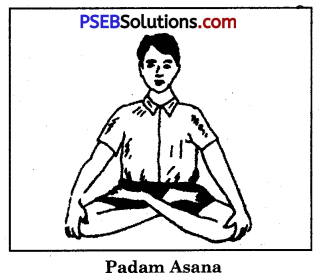
Technique of Padam Asana:
After having sat in squat position, place your right foot on the left thigh in such a way that the heel of the right foot touches the hip bone of the left thigh. After this, lift up the left foot and in the same way place it on the thigh of the right foot. The vertebral column should be perfectly straight. Stretch the arms on the knees. It becomes very easy to do this asana after a few days practice.
Advantages:
- This asana stimulates the digestive system.
- It is very useful for increasing the concentration of mind.
- Backache disappears.
- One does not become a victim of the diseases of heart and belly.
- It removes urinary troubles.
3. Svastik Asana: In this asana, one places the loose thighs in between the lower legs.
4. Sarvang Asana: In this asana, one stands on one’s shoulders.
Technique of Sarvang Asana: In this asana, the position of the body is like that of Ardh-hal-asana. In order to do this asana, straighten the body and lie on the ground over the back. Place both the hands along the thighs. Lift the feet once and resting the back with the help of wrists, let the elbows rest on the ground. Keep the whole body straight. Let the body weight fall on the shoulders and the neck.
Let the chin touch the neck.
After having remained in this position for sometime, return gradually to the former position. In the initial stage, do the asana for a minute or two. Then the duration of the asana should be increased from 5 to 7 minutes. The persons who cannot do Sheershasana for some reason should do Sarvang Asana.
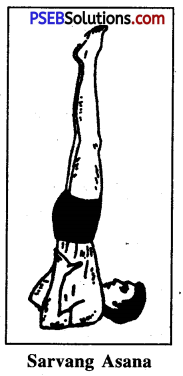
5. Halasana:
Position-
In doing this asana one lies in the supine position.
Technique:
- Raise both legs and keep head away and lift both feet and bring both legs behind the head.
- Touch the thumb of your feet of the ground.
- Maintain the position as you can.
- Bring your feet at the same place from where you have started to left.
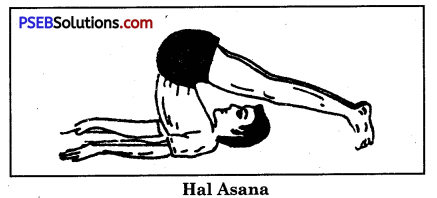
Advantages:
- Hal Asana is very useful for every men and women of every age.
- It is the best asana for the person of heart disease or a person who is suffering from high or low blood pressure.
- It regulates the circulation of blood.
- Removes fat of the body slim the waist and belly.
- It provides flexibility to the backbone.
- It make the body beautiful.
- The face starts glittering like the sun.
- It prevents skin diseases and removes constipation.
6. Garur Asana:
The position of Garur Asana in standing on both feet.
Techniques:
- While standing straight, lift the left leg and encircle the other leg.
- Left thigh will come over right thigh. The part of the lower leg will cover right side of the lower leg.
- Put the body weight on one foot.
- Encircle left arm to the right arm and left. Both palm and come to the position of Namaskar.
- Then bend the left leg and bring the body in sitting position. In this way all nerves of the body will get stretched.
- Again straighten up the body and come to the position of Attention.
- Now change you legs and hands and repeat the same. Garur asana should be performed on each leg from one minute to five minutes.
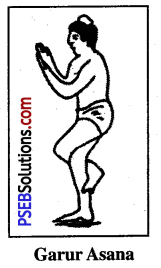
Advantages of Garur Asana:
- It strengthens all parts of the body.
- Body becomes healthy.
- It prevents the diseases of Hernia.
- Legs become strong.
- One feels fresh and light.
- Circulation of blood increases.
- Man remains healthy and away from so many diseases.
7. Searsh Asana:
Position: Bring your head down and keep legs upward.
Technique:
- Put blanket or towel on the floor and sit down on your knees.
- The fingers of both hands should be tightly interlocked put both hands on blanket.
- Put your head between both hands in such a any that thumb of the hand may press back part of your head.
- Bring both legs inside and put your thumb and legs straight upward.
- Lift the feet gradually. Firstly straight one leg and another.
- Try to keep your body in a straight line.
- Put your body weight on head and both arms equally.
- You can take help of the wall or your team-mates.
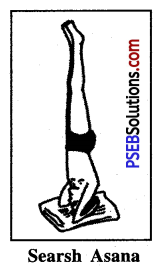
Advantages:
- Increases appetite.
- Make a person slim.
- Live and spleen become more active.
- It removes all diseases concerning primary track.
- Piles are cured.
- By doing regular parctice of Searsh Asana, mental diseases are cured.
Precautions:
- When eyes become red, Asana should be stopped.
- On feeling giddiness don’t do Searsh Asana.
- Searsh Asana should sbe stopped while feeling too much air in the ears.
- This asana should not be performed when inhalation becomes difficult.
- When body do not bear the weight.
- On shivering arms and legs.
- While feeling uneasiness, Searsh Asana may not be performed.
- Searsh Asana should be performed all alone.
- Take assistance when you feel necessity.
- Searsh Asana can be performed from one minute to five minutes. More time would be harmful.
8. Vajur Asana:
Position Sitting on legs while keeping his feet behind.
Technique:
- Put on knees under your hip and sit down while facing the feet upper side.
- The thumb of the feet should touch each other.
- Both the knees may touch each other back and waist must be in a straight line.
- Put both hands on the both thigh.
- Breathing may be long.
- Vajur Asana may be performed daily from three minutes to twenty minutes.
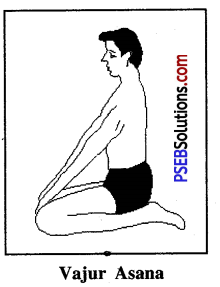
Advantages:
- Body becomes more active.
- Removes the fats of the body.
- Body becomes healthy.
- Muscles get strengthened.
- It helps to get rid to Night fall. Vajur Asana
- It removes the pain of feet and legs.
- Mind becomes cool.
- Person becomes care free.
- It cures diabetes.
- It improves digestion.
9. Yog Mudra:
In Yog Mudra, one sits in the position of Padamasana, bends the trunk and rests the head on the ground.
10. Mayur Asana:
In this asana, the body is balanced on the elbows in the horizontal position. The palms are placed on the ground.
![]()
11. Uddiyan:
In this asana, one keeps the feet separate, stands and bends the trunk forward. The hands are placed on things. Then one breathes out and copies breathing in, below the ribs.
12. Pranayam :
Anulom Vilom- In this asana, one sits down breathes in for a fixed time, holds the breath with the help of chin and breathes out.
Advantages: This asana cleanses the blood, nerve and mind.
13. Surya Namaskar:
Surya Namaskar has sixteen components but the sun having sixteen phases appears at the time of total annihilation of the universe. Normally, only twelve components of its are practised.
Advantages:
It is the best Yogic exercise. It yields the benefits of asana, mudra and pranayam. The body of the one who practises Surya Namaskar glitters like the sun. It prevents skin diseases. It removes constipation. The spinal cord and waist become flexible. The pregnant women and patients of hernia should not practice it.

14. Shav Asana.
In this asana, one lies down prostrate and loosens the body. In order to perform this asana, lie down straight on the ground over the back and loosen all the parts of the body completely. Gradually, breathe in deeply. The distance between the feet should be 1.5 ft. Keep the wrists of the hands away from the body, facing the sky. Close your eyes, introspect and think as if the body were getting loose. Feel that the body is in a position of rest. This asana should be performed for 3-5 minutes. It should be performed at the start and end of every asana.
Importance:
- Shavasana helps in getting rid of high blood pressure and mental tension.
- It keeps the heart and the brain fresh.
- It removes the fatigue in the body.